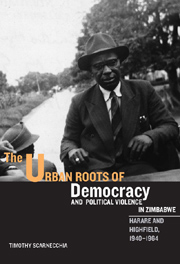Book contents
- Frontmatter
- Contents
- List of Illustrations
- Acknowledgments
- List of Abbreviations
- Notes to the Reader
- Introduction
- 1 Charles Mzingeli's Leadership and Imperial Working-Class Citizenship
- 2 Township Protest Politics
- 3 Resistance to the Urban Areas Act and Women's Political Influence
- 4 Changing Tactics: Youth League Politics and the End of Accommodation
- 5 The Early Sixties: Violent Protests and “Sellout” Politics
- 6 The “Imperialist Stooge” and New Levels of “Sellout” Political Violence
- 7 The ZAPU-ZANU Split and the Battlegrounds of Harare and Highfield
- Conclusion
- Notes
- Selected Bibliography
- Index
- Title in the series
7 - The ZAPU-ZANU Split and the Battlegrounds of Harare and Highfield
Published online by Cambridge University Press: 12 September 2012
- Frontmatter
- Contents
- List of Illustrations
- Acknowledgments
- List of Abbreviations
- Notes to the Reader
- Introduction
- 1 Charles Mzingeli's Leadership and Imperial Working-Class Citizenship
- 2 Township Protest Politics
- 3 Resistance to the Urban Areas Act and Women's Political Influence
- 4 Changing Tactics: Youth League Politics and the End of Accommodation
- 5 The Early Sixties: Violent Protests and “Sellout” Politics
- 6 The “Imperialist Stooge” and New Levels of “Sellout” Political Violence
- 7 The ZAPU-ZANU Split and the Battlegrounds of Harare and Highfield
- Conclusion
- Notes
- Selected Bibliography
- Index
- Title in the series
Summary
This chapter examines the leadership split in the nationalist movement and the subsequent ramifications in Harare and Highfield. The decision by the breakaway executive of ZAPU to form a new party in the summer of 1963 led to a struggle that would culminate in intramovement violence. This development was welcomed by the Southern Rhodesian state, especially as the Rhodesian Front took advantage of the political violence to legitimate its draconian measures to “maintain law and order,” while actually using these laws to divide and dismantle the leadership of the nationalist movement. In addition, given the physical layout of the townships and their relative isolation from European residential areas, the government could allow factions to battle against each other at the cost of township residents with little complaint from white voters.
Eugene Wason, the editor of the Daily News from 1962 to 1964, was among a small but vocal group of Europeans critical of this policy, and he would later describe how it was the state's policy to carry out sweeps of the townships every six months or so to make arrests, but otherwise the authorities were content to watch as the two factions used intimidation, petrol bombs, and beatings in their own attempts to take control of the townships. The factionalism also allowed the government's Special Branches to arrest leaders at will or, at other times, to covertly participate in the township violence and make it appear as part of the daily reality of political violence.
- Type
- Chapter
- Information
- The Urban Roots of Democracy and Political Violence in ZimbabweHarare and Highfield, 1940–1964, pp. 134 - 157Publisher: Boydell & BrewerPrint publication year: 2008



